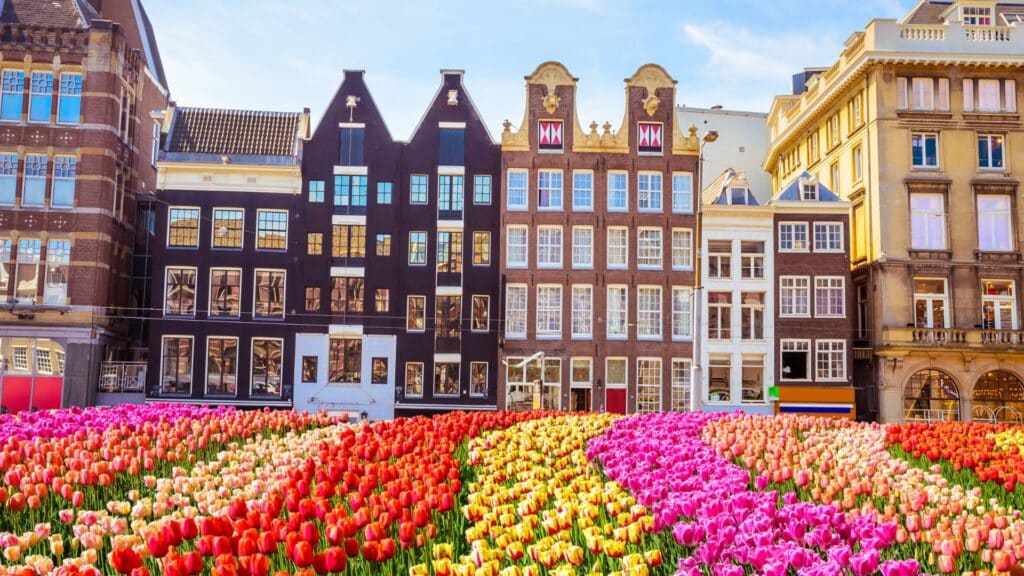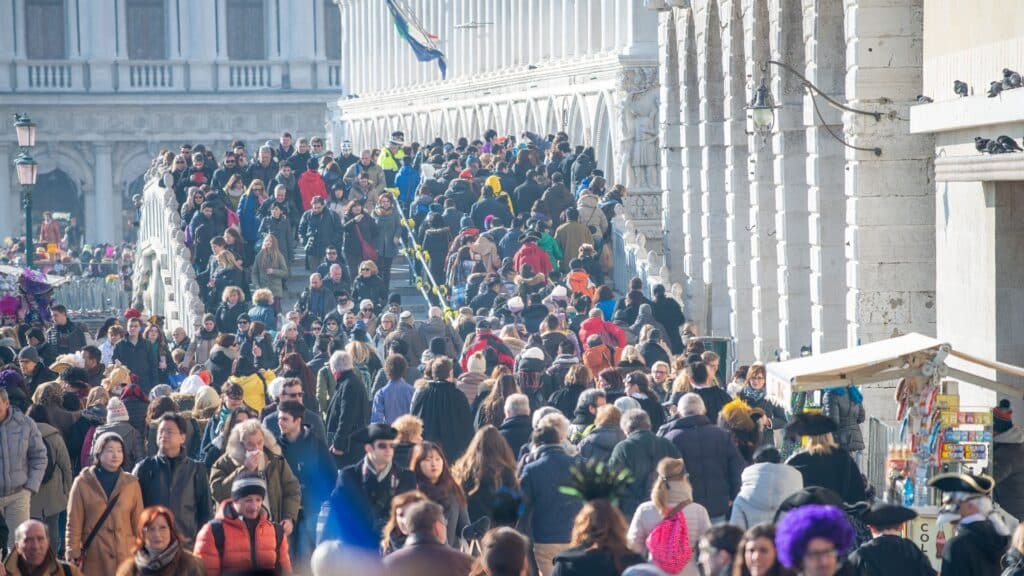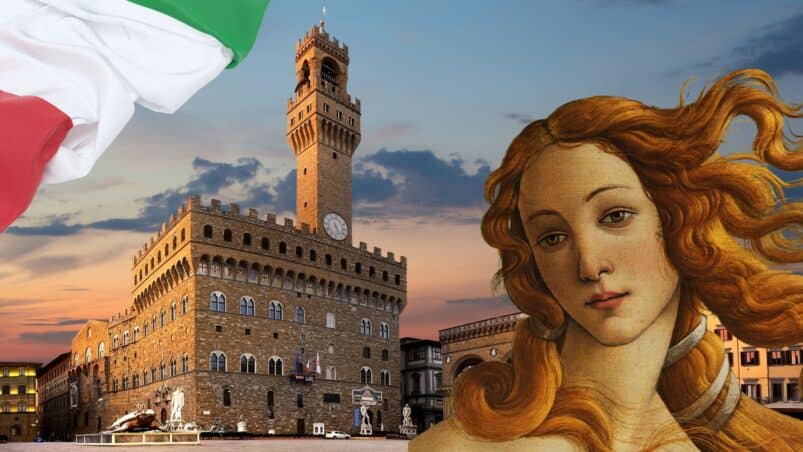Italy’s latest tourism campaign has sparked criticism among some Italians, who are unhappy with its use of clichés. The campaign, which features a digital version of Botticelli’s Venus, is part of a €9 million yearlong initiative called “Open to Meraviglia” (Open to Wonder), aimed at attracting young tourists. While some defend the use of stereotypes, critics argue that the campaign trivializes Italy’s cultural heritage and fails to represent the country’s true diversity. There are also concerns that the campaign is promoting tourism in a way that is harmful to the environment and local communities.
The yearlong campaign “Open to Meraviglia” (Open to Wonder) is aimed to attract young tourists. Italy hopes to bolster its economy and tourism sector, as it’s still recovering from the downturn in travel, largely caused by the pandemic. The country hopes this year will see a record-breaking influx of tourists.
The campaign, which officially starts in May, costs an estimated €9 million and was produced by national tourism agency ENIT and advertising group Armando Testa. A large chunk of the budget will be used for the dissemination of the campaign at transport hubs across the world, an analysis from Italian marketing company Marketing Espresso showed.
Minister of Tourism Daniela Santanché explained the decision to present Venus as a virtual influencer on social media was made to showcase Italy in a different way. “One of the objectives of this international campaign is to reach out to young people, so we used the instruments and language close to them,” she said in a radio interview TIME reported. “I consciously chose Botticelli’s Venus, an icon known throughout the world and a symbol of our Italian spirit.”
Criticism on Clichés
However, despite the ‘new way’ of presenting Italy through a virtual influencer, many people are not happy that the representation is mostly made up of typical clichés of Italian culture; Venus is a hip fashionista, snapping selfies in Venice’s St. Mark’s Square, eating pizza on Lake Como and posing in front of the Colosseum in Rome on a bike. She posts them on Instagram to her (at the time of writing) 200.000 followers
Cultural professionals such as art historian Livia Garomersini were far from pleased with the ‘one-dimensional presentation’ of Italian culture according to ArtNet: “Where is the art? Where is the promotion in this hackneyed jumble of clichés?” She said the campaign “trivializes our heritage in the most vulgar way.” Another commentator sneered that the campaign transforms “Botticelli’s Venus into Barbie”, the New York Times reported.
Other criticism was aimed towards the inclusion of stock images and a promotional video featuring a winery in Slovenia, used as a stand-in for Italy. And the overall execution of the campaign falls flat, with poorly photoshopped images and the debatable slogan ‘Open to Wonder’. People even made mocking videos and memes. And whether the campaign will even speak to young tourists remains to be seen as well.
After all, we were also the first to want Italian cuisine to be included in the UNESCO intangible heritage list
Roberta Pisa
Stereotypical but effective
But is it even possible to create a successful campaign without featuring the ‘cliché’ of heritage sites and cultural stereotypes? It would certainly be very difficult. Visit for example the Dutch National Board of Tourism & Conventions’ website, where you are greeted by images and videos of blossoming tulips, picturesque waterways and Vincent van Gogh. Typical clichés of Dutch culture, and not representative of the diversity in the Netherlands. Yet it is very effective.

Roberta Pisa, publicist and writer at Artibune reckons that her fellow countrymen underestimate how well stereotypical images work to attract tourists, whether they like it or not. “After all, and rightly so, we were the first to want Italian cuisine to be included in the UNESCO intangible heritage list, a long-standing boast of our food and wine culture. And now we are calling for Italian cuisine to be included along with pizza.” Perhaps the thing that stands out the most to Pisa is ‘the choice of wanting to show ourselves at all costs to be different from what we are: young, influential and great communicators.’
So aren’t people too quick to criticize the campaign before it even has gotten underway? If the campaign turns out to be a huge success in attracting many tourists, the country will also have the opportunity to show visitors that there is more to Italy than just clichés.
Overcrowded
However, the cliché content isn’t the most pressing issue: if you look past the so-so campaign itself, some Italians are wondering whether the country needs more tourists at all. Italy has been dealing with overcrowding for years, and these new campaigns aim for even more people to visit the most well-known landmarks.
Professor of Economics of Culture at the Iulm University of Milan Pierluigi Sacco argues that ‘Italy doesn’t need more tourism, but better tourism.’ His words in Italian economic newspaper Sole 24 Ore are echoed in Start Magazine: “Tourism should be less impacting from a socio-environmental point of view and more interested in an experiential dimension that is not taken for granted, and tourism that does not crowd the usual places.” In Europe we already see a similar trend of tourism boards looking to promote ‘off-the-beaten-path’ tourism to spread visitors over a larger area to battle overcrowding, such as in Berlin.

Economic Pillar
On the other hand, does Italy have a choice? The tourism sector is an important economical pillar. For example, in 2019 tourism directly accounted for 6.2% of the total Gross Value Added, or €99 B, according to the Organisation for Economic Cooperation and Development (OECD). The sector directly employed 2.1 million people, contributing 8.8% of total employment. While 2022 saw a decent recovery (but still 58% below 2019 levels), Italy is hoping for a busy summer.
In the long term, the Italian government is also focusing on boosting the sector to make sure as many people can visit well-known landmarks. In April the Ministry of Culture announced plans to open a high-speed rail connection (costs €35 M) between Rome and the ancient city of Pompeii, in a bid to ramp up tourism to the archaeological site and other popular locations. A large investment in infrastructure would make it easier to stretch large amounts of tourists across the country.
Future
While the criticism about the mediocre quality of the campaign might be warranted, only time will tell if Venus turns about to be a successful influencer, boosting visitor numbers of Italian cultural sites and landmarks. Using stereotypes and clichés might attract a certain kind of tourist, who mostly looks to visit the most well-known sites. However, marketing cultural clichés happens quite often, with effect.
But the question remains how Italy will cope with the large influx of tourists every year, even if it is an important economic pillar of the country. And if they aim to hit pre-pandemic numbers in 2023, they might have to make difficult decisions in the near future.

